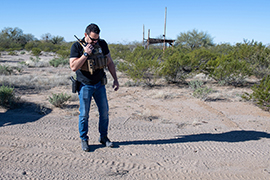- Slug: BC-CNS-Migrant Tumble,810 words.
- Photo, graphic available (embed code, thumbnail, caption below)
By Ian McKinney
Cronkite News
WASHINGTON – Border encounters plunged from record highs of more than 300,000 in December to 176,205 in January, a 42% drop that Customs and Border Protection attributed to enforcement efforts and a traditional seasonal drop.
While most people welcomed the drop, few were confident that it will remain at this level – a level that critics said should still be considered a “crisis.”
“When this is considered to be a good month at the border, that’s when you know that things are really bad. … If you look at historic trends it is still extraordinarily high,” said Ira Mehlman, a Federation for American Immigration Reform spokesperson.
“January tends to be a month where you see a dip pretty much every year. It’s too early to be taking a victory lap … when in fact this is not a victory at all,” he said.
The drop comes as Congress and the White House remain deadlocked over immigration reform.
The Senate last week rejected a sweeping bipartisan plan that would have increased funding for border enforcement, reformed the asylum process and given the president authority to shut down the border. The GOP-controlled House, meanwhile, is insistent on a hardline measure it passed last year that has since gone nowhere in the Senate.
That led a group of moderate Democrats to unveil their own plan Thursday, arguing that nothing on the border will improve without comprehensive immigration reform.
“Restoring order to the southern border is critical for the United States of America. And we can only do that with more boots on the ground and with improved technology,” said Rep. Greg Stanton, D-Phoenix, part of the New Democrat Coalition that said their plan would do just that.
The coalition’s 11-point framework calls for an additional 2,000 Border Patrol officers and improved technology to stop the flow of fentanyl and other drugs. But much of their plan calls for creating pathways to citizenship for undocumented immigrants who have been in the country working and paying taxes for years.
“These are young people who are doing amazing things to support this community. They’re going to college and serving in the military, serving this community,” Stanton said. “The fact that they theoretically could be deported … and that we can’t vote in the Congress to provide a path to citizenship for these Dreamers is not only immoral, but it is self-defeating for our economy.”
Southern Border Communities Coalition Director Lilian Serrano said Congress has a long way to go to fix an immigration system that she says is decades behind where it should be.
“Our border is not a scary place. For many of us who have been living along the US-Mexico border for generations, we are not afraid of the people coming from all over the world,” Serrano said. “We know that people coming are not the problem. The problem is our immigration system is still stuck back 30, 40 years in the past.”
Serrano said both sides are stuck on what she called “enforcement-only policy, quote-unquote, ‘solutions’ to the problem. What we really need is to reimagine how we reapproach the border.”
“We know that there are still conversations in Congress around closing the border and while I don’t think that was the sole reason for the decrease in migration (in January), the way that information was given to the rest of the world did have an effect on groups of migrants and if they decide to come in,” she said.
But Mehlman said the most effective border solution is already on the table: H.R. 2, the bill that passed the House in May 2023 but has yet to be acted upon by the Senate. It would tighten asylum and parole rules, and call for border wall construction to resume, among other things.
“That is a bill that systematically goes through all the loopholes or discretionary authority this administration has claimed they’ve had in enforcing our laws and correcting those,” Mehlman said of H.R. 2. “The Senate bill did nothing of the kind which is why it crashed and burned.”
Despite his opposition to H.R. 2, Stanton said the results of this week’s special election in New York should serve as a signal to party leaders that voters want compromise – and some form of action on immigration. He said “immigration and the border were front and center” in the race for New York’s 3rd District, which flipped from Republican to Democratic on Tuesday.
“They (Republicans) thought that they could do nothing and then use the border and immigration as a cudgel against Democrats. And I think they learned that in that New York 3 race, that doing nothing is not just bad policy for America, it’s bad politics for Republicans,” Stanton said.
“And actually doing something, reaching across the aisle to do a bipartisan agreement is good for them substantively and politically,” he said.
For more stories from Cronkite News, visit cronkitenews.azpbs.org.
^__=
Web links:
_ CBP data: https://www.cbp.gov/newsroom/stats/southwest-land-border-encounters
_ CBP statement: https://www.cbp.gov/newsroom/national-media-release/cbp-releases-january-2024-monthly-update
_ Border sectors: https://www.cbp.gov/newsroom/stats/southwest-land-border-encounters-by-component
_ Senate bill: https://www.sinema.senate.gov/wp-content/uploads/2024/02/Bipartisan-Border-Security-Package-Summary.pdf
_ New Democrat bill: https://stanton.house.gov/2024/2/stanton-new-democrat-coalition-immigration-and-border-security-task-force-unveils-framework-for-commonsense-immigration-reform-calls-on-republicans-to-join-democrats-in-tackling-border-security
_ H.R. 2: https://www.congress.gov/118/bills/hr2/BILLS-118hr2pcs.pdf
_ H.R. 2 summary: https://www.cbo.gov/system/files/2023-05/hr2.pdf
_ New York results: https://nyenr.elections.ny.gov/
_ Graphic embed code: <div class=”flourish-embed” data-src=”story/2175537″><script src=”https://public.flourish.studio/resources/embed.js”></script></div>
^__=
A “Shadow Wolf” – an all-Indigenous unit of Immigration and Customs Enforcement that patrols the border in the Tohono O’odham Nation – calls in his sighting of footprints and vehicle tracks in the Arizona desert in this February 2023 photo. (Photo by U.S. Immigration and Customs Enforcement)
